
Posted by Ross
Thu, 17th Apr 2014

Hi everyone,
Although last week I mentioned that art style would be the subject of this week’s Flame Over blog post, I’ve had a rethink. Given that our concept artist is on a well-deserved break I’ll be discussing the equipment that Flame Over’s hero, Blaze Carruthers, uses to combat the game’s fires instead.
Blaze primarily makes use of three items of equipment: his Fire Hose, Extinguisher and Axe. He also has a very limited supply of water bombs with which to combat those infernal infernos. :) Here’s a breakdown of each:
Fire Hose:
The fire hose operates like a fairly standard gun in a twin stick shooter. It fires in a limited-range beam, aimed using the Vita’s right stick and fired by pressing the R button, meaning you can aim independently of Blaze’s movement direction.
The Fire Hose has a pretty long-but-limited range and any fires within its path will be quickly downgraded in rank until they are extinguished altogether.
The fire hose uses water from a tank on Blaze’s back, giving you a limited supply with which to tackle each level’s flames. Luckily, you can find extra water at sources such as kitchen or bathroom sinks, water coolers, or water fountains. Each water source refills your tank at a different rate, so it pays to be choosy… ;)
Once a fire is out, or if you just want to be extra safe, you can squirt areas of the level that aren’t on fire with the Fire Hose to soak them. Soaking an area means fires will need more time before they can ignite it, buying you some precious seconds to bring the rest of the area under control. This is particularly important when trying to keep more flammable materials like plants and fabric in check.
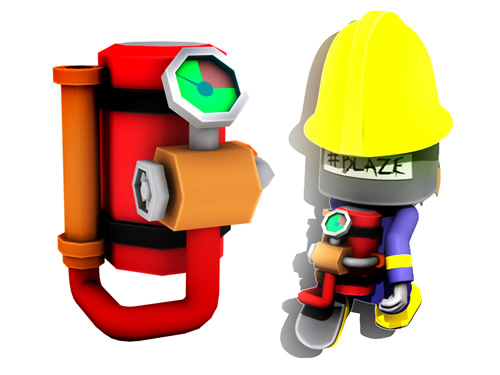
Extinguisher:
Blaze’s extinguisher can be used to put out fires. It’s very efficient and deals with fires even faster than the hose, but has an even more limited ‘ammo’ supply so should be used sparingly. The extinguisher has a wider ‘cone’ of fire and a shorter range than the hose, so it could be considered as a shotgun to the fire hose’s rifle. ^^ Like the hose, the extinguisher is aimed with the right stick, but is fired via the L button.
The extinguisher’s primary function is for use on electrical fires. Electrical fires have a very nasty habit of helping regular fires spread FAR more quickly, so they need to be dealt with as a priority. It’s therefore advised that you try to limit your extinguisher for use on electrical fires as much as possible.
Once your extinguisher is used up you can look for an extinguisher point (usually in a corridor!) for a once-only resupply, or head all the way back to the starting area, where an infinite stash of extinguishers can be found.
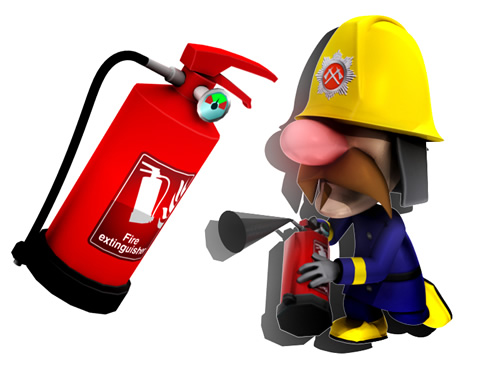
Axe:
Blaze’s Axe is a stalwart companion and is required to access certain areas of the game sealed off by fire barriers. Blaze must swing away at the doors quickly enough to break through them. Each time a door is smashed the axe loses some durability, so Blaze will need to keep an eye out to ensure he doesn’t run out and lock himself out of a room! As with the extinguisher, axe points can be found in some corridors to provide a once-use-only replacement, or you can head back to your starting area for an infinite supply of axes.
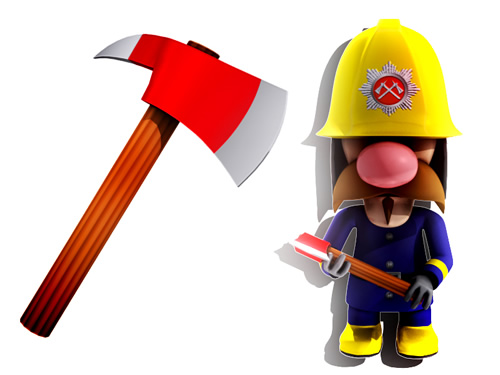
Water Bombs:
Blaze’s most devastating weapon against conventional flames is the water bomb. Like a kind of water-based percussion grenade, these detonate on impact and burst over a wide area, instantly extinguishing any fires in range and soaking the area to boot. Water bombs are great for clearing areas to move Blaze into, helping you avoid being cooked in high-danger areas or when too many flames are in close range to deal with safely.
Water bombs are limited in supply and kinda tough to replace, so you’ll need to save them for emergencies! On the downside, they are useless against electrical fires, so bear that in mind.
Well, hopefully that look into Blaze’s arsenal has ‘wetted’ your appetite (you don’t know how it pains me to include an intentional spelling error, but a joke’s a joke!) for more news on Flame Over next week.
Until then, have a Happy Easter. ^^
Al
Posted by Ross
Thu, 10th Apr 2014

Hello all,
Since last week’s blog where we described some of Flame Over’s basic gameplay, this week I’ll be telling you about the game’s fire system, the beating heart of the entire Flame Over experience!
Interspersed in this post are 4 screens from Flame Over’s Unity scene view, showing how a typical fire spreads over 25 seconds if left to its own devices… ;)
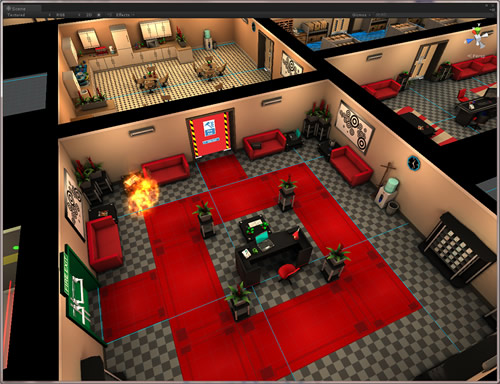
Above: You can see the fire in this room has started in the top left corner. Doesn’t look too dangerous at the moment, right?
The goal at the outset was to create dangerous fires that can be set randomly and then relied on to spread and endanger NPCs and the player, without faking any behaviour. Here’s how we did it…
Each room in Flame Over is designed and built by hand (from a resource of hundreds of different fuel objects) over a tile map that all furniture and level geometry must fit within. Larger stuff like desks might stand inside multiple tiles, while little things like pot plants can fit sit inside a single tile.
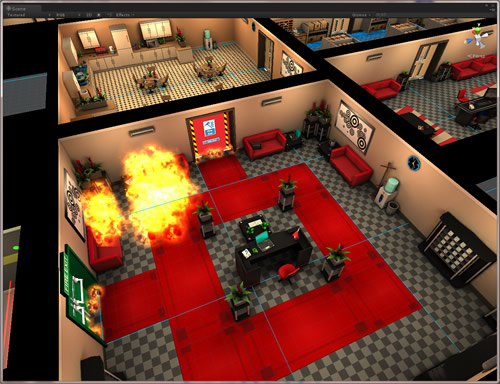
Above: After around 10 seconds the fire has jumped to the nearby sofas. These are made of fabric which is nice and combustible! The temperature has climbed high enough to create the danger of backdrafts on nearby doors…
Each tile in a level holds data enabling it to constantly ask various questions, like:
“Have I got a burnable object on me?”
“What is my object made of?” (fabric, wood, metal, etc.)
“Does my object hold an item?” (More on that in the future!)
“Am I wet?”
“Am I on fire?”
“How big is my fire?”
“Can I spread yet?”
“How much fuel do I have left?”
All of our tiles are asking these questions all of the time, which means Flame Over is really pushing the Vita’s CPU, but luckily it’s a powerful beast and is more than up to the task. The great thing is that because all these calculations are being handled in the background, you can concentrate on guiding the game’s hero - Blaze Carruthers - around the levels, squirting your hose, rescuing cats and generally being a legend! ^^
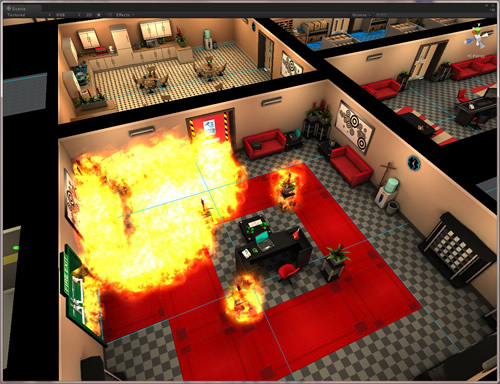
Above: Just five seconds later and the oldest fires in this group have grown in size enabling them to ignite more distant objects instantaneously, such as the poor pot plants in the centre of the room.
Although Flame Over is a real-time game, fires update on a turn-based system. We can set how frequently each turn occurs, and how things like different materials or fuel amounts or flame sizes alter those values, to ensure fires behave in predictable, but interesting and dangerous ways.
Currently, for example, carpets and rugs are very dangerous as they ignite pretty quickly and can spread underfoot, spreading to burn poor Blaze scarily quickly. You’ve been warned: keep those carpets soaked!! O_o
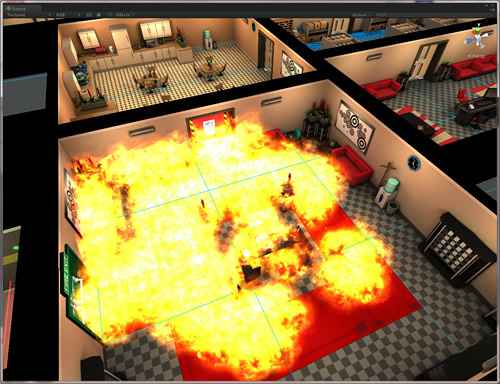
Above: After 25 seconds the tougher wooden desk has all succumbed to the flames, as has the computer on top and areas of the rug behind it… This is going to need a lot of water to put out!
One last thing to mention – which I’ll be touching on in the coming weeks – is that depending on how much fire is in a room, various fire-related hazards can appear. This can make life even trickier for poor old Blaze, but more on that in future posts! ^^
Well, I’ve already written far too much so I’ll leave it there, but be sure to drop back in next week to find out more about Flame Over’s art style.
Bye! ^_^
Posted by Ross
Fri, 4th Apr 2014

Hello all,
After last week’s Flame Over reveal, now I’d like to talk a bit more about some of the gameplay systems it features.
At its heart, Flame Over is an action game about putting out fires against the clock. In practice this means racing around each level, finding your way through its nooks and crannies to rescue workers and cats and – most importantly – to put out every single fire, every single time!
At the start of each Flame Over level, your hero Blaze Carruthers begins in a safe area, away from the flames. He’ll return there once all fires are out in order to exit the level. However, in the meantime there’s the small problem of controlling a raging inferno and rescuing workers and cats from the merciless flames!
When you start a level in Flame Over its structure is unknown and all rooms outside the safe area are veiled in blackness until you have entered them for the first time. To help you find your way around you have a mini map which gives you a clue to surrounding room layouts and helps you find important stuff like water sources, extinguishers and axes, all of which you’ll need to beat each level.
You also have a thermometer that allows you to play a game of ‘hotter or colder’ with the fires. As you near a heat source the mercury will rise. As you move away, it’ll sink back down. Using the map and thermometer you’ll need to prioritise your route through the level to get everything done in time.
The screens in this blog post show these elements in action, but please bear in mind these images are are very much ‘work in progress’, with many GUI and other graphical elements either missing or placeholder. :)
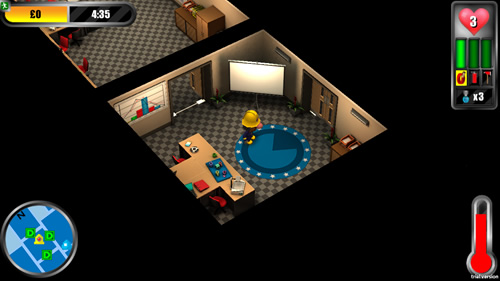
Above: Your game area starts off filled with mysterious blackness. The mini-map in the bottom left shows that are rooms to your east, west and south you’re yet to discover. The thermometer is high, so a fire must be very close by!
As you run around the rooms and corridors you’ll come across office workers and cats in need of rescue. Rescuing people is super-important as each one returned to the safe area tops up your time, while each worker lost means a hefty time deduction, and with it, maybe game over!
Cats, while not so critical, can be returned to earn Blaze a much needed point of HP. And you’ll need it, because in Flame Over there are a lot of ways to lose health…
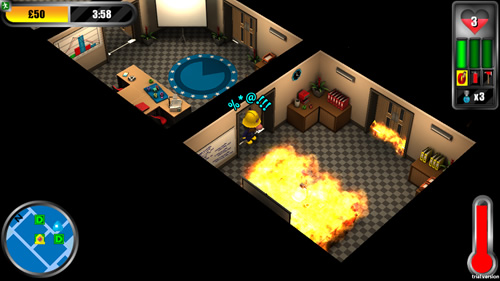
Above: You enter the room, and can see that your thermometer was right: a well established fire in a kitchen! Time for action!!
As you make your panicked way through the game you’ll obviously be using your hose, extinguisher and axe to get the job done. Controls are very simple and in the traditional ‘twin stick’ tradition but you’ll need to keep an eye on your water, foam and axe levels. All your equipment will run out in time, so keeping tabs on nearby water sources and extinguisher points will also prove vital if you’re to make it beyond the first level or two.
I think that’s enough for this week. :) Next week I’ll be explaining Flame Over’s fire system in more depth, so be sure to come back to the LJ blog then. For more details on other game features and inside info, be sure to keep an eye on the blog and our Twitter feed and Facebook pages in the coming weeks.
For now, I’d best get back to fire fighting. Bye! ^^
















